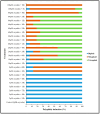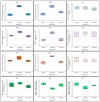Machine Learning-Aided Optimization of In Vitro Tetraploid Induction in Cannabis
- PMID: 40004209
- PMCID: PMC11855134
- DOI: 10.3390/ijms26041746
Machine Learning-Aided Optimization of In Vitro Tetraploid Induction in Cannabis
Abstract
Polyploidy, characterized by an increase in the number of whole sets of chromosomes in an organism, offers a promising avenue for cannabis improvement. Polyploid cannabis plants often exhibit altered morphological, physiological, and biochemical characteristics with a number of potential benefits compared to their diploid counterparts. The optimization of polyploidy induction, such as the level of antimitotic agents and exposure duration, is essential for successful polyploidization to maximize survival and tetraploid rates while minimizing the number of chimeric mixoploids. In this study, three classification-based machine learning algorithms-probabilistic neural network (PNN), support vector classification (SVC), and k-nearest neighbors (KNNs)-were used to model ploidy levels based on oryzalin concentration and exposure time. The results indicated that PNN outperformed both KNNs and SVC. Subsequently, PNN was combined with a genetic algorithm (GA) to optimize oryzalin concentration and exposure time to maximize tetraploid induction rates. The PNN-GA results predicted that the optimal conditions were a concentration of 32.98 µM of oryzalin for 17.92 h. A validation study testing these conditions confirmed the accuracy of the PNN-GA model, resulting in 93.75% tetraploid induction, with the remaining 6.25% identified as mixoploids. Additionally, the evaluation of morphological traits showed that tetraploid plants were more vigorous and had larger leaf sizes compared to diploid or mixoploid plants in vitro.
Keywords: classification; leaf-related morphological traits; optimization algorithm; oryzalin; plant tissue culture; polyploidy.
Conflict of interest statement
The authors declare no conflicts of interest. The funders had no role in the design of the study; in the collection, analyses, or interpretation of data; in the writing of the manuscript; or in the decision to publish the results.
Figures






Similar articles
-
Comparative assessment of morphological, cytological, and photosynthetic characteristics of the induced octoploid and its tetraploid counterpart of Celosia argentea L.BMC Plant Biol. 2024 Dec 21;24(1):1227. doi: 10.1186/s12870-024-05973-x. BMC Plant Biol. 2024. PMID: 39709350 Free PMC article.
-
Chromosome doubling in a Rosa rugosa Thunb. hybrid by exposure of in vitro nodes to oryzalin: the effects of node length, oryzalin concentration and exposure time.Plant Cell Rep. 2007 Nov;26(11):1977-84. doi: 10.1007/s00299-007-0411-y. Epub 2007 Jul 20. Plant Cell Rep. 2007. PMID: 17641861
-
Effect of induced polyploidy on some biochemical parameters in Cannabis sativa L.Appl Biochem Biotechnol. 2015 Mar;175(5):2366-75. doi: 10.1007/s12010-014-1435-8. Epub 2014 Dec 10. Appl Biochem Biotechnol. 2015. PMID: 25492688
-
Studies on Colchicine Induced Chromosome Doubling for Enhancement of Quality Traits in Ornamental Plants.Plants (Basel). 2019 Jun 28;8(7):194. doi: 10.3390/plants8070194. Plants (Basel). 2019. PMID: 31261798 Free PMC article. Review.
-
Effect of Polyploidy Induction on Natural Metabolite Production in Medicinal Plants.Biomolecules. 2021 Jun 17;11(6):899. doi: 10.3390/biom11060899. Biomolecules. 2021. PMID: 34204200 Free PMC article. Review.
Cited by
-
Induction of autotetraploid and morphological, anatomical, and cytological studies of Trichosanthes cucumerina Linn.BMC Plant Biol. 2025 Aug 9;25(1):1059. doi: 10.1186/s12870-025-07130-4. BMC Plant Biol. 2025. PMID: 40783716 Free PMC article.
References
MeSH terms
Substances
Grants and funding
LinkOut - more resources
Full Text Sources

